Sustainability and Tourism Competitiveness in Protected Areas: State of Art and Future Lines of Research
Abstract
1. Introduction
- RQ1.
- What pattern and trend is followed by knowledge accumulation on sustainability and tourism competitiveness in protected areas?
- RQ2.
- What is the impact of the knowledge generated?
- RQ3.
- What is the social structure of this field of knowledge? Where is knowledge generated, in which countries, in which institutions, and what are the international relationships between those knowledge generating centres?
- RQ4.
- What is the conceptual structure of the field? What are the main topics addressed by researchers?
- RQ5.
- What is the intellectual structure of the field? What are the open lines of research, the emerging research areas, and the possible future approaches?
- RQ6.
- Does research in sustainability and tourism competitiveness in protected areas follow the guidelines of research in sustainable tourism?
2. Background
2.1. Bibliometric Analysis on Tourism Sustainability
2.2. Competitiveness and Sustainability of Protected Area Tourist Destinations
3. Research Methodology
3.1. Literature Retrieval
3.2. Bibliometric Analysis
4. Results
4.1. Patterns, Trend, and Influence of the Generated Knowledge
4.2. Knowledge Structure
4.2.1. Social Structure
4.2.2. Conceptual Structure
4.2.3. Intellectual Structure: Network Analysis and Key Research Topics
5. Discussion
5.1. Cluster 0: Destination Competitiveness
5.2. Cluster 1: Carrying Capacity
5.3. Cluster 2: Socio-Cultural Factors
5.4. Cluster 3: Tourism Planning and Communication
5.5. Cluster 4: Tourism Sustainability
5.6. Cluster 5: Governance
5.7. Cluster 6: National Park
5.8. Cluster 7: Special Featured Areas
6. Conclusions and Direction for Future Research
Author Contributions
Funding
Acknowledgments
Conflicts of Interest
Appendix A
| Cluster | Citing Paper | Global Citation Score (GCS) | Coverage | Most Frequent Cited Paper in Recent Years |
|---|---|---|---|---|
| 0 Destination competitiveness Silhouette 0.8 Mean (year) 2007 | [120] | 19 | 9 | Ritchie JRB, 2003, Competitive Destinat, V0, P0 Dwyer L, 2003, Current Issues In Tourism, V6, P369 Enright MJ, 2004, Tourism Manage, V25, P777, Doi 10.1016/J.Tourman.2004.06.008 |
| [117] | 10 | 2 | ||
| [118] | 6 | 2 | ||
| [115] | 5 | 12 | ||
| [116] | 1 | 8 | ||
| [119] | 1 | 5 | ||
| 1 Carrying capacity Silhouette 0.662 Mean (year) 2007 | [122] | 21 | 3 | Andereck KL, 2005, Ann Tourism Res, V32, P1056, Doi 10.1016/J.Annals.2005.03.001 Gossling S, 2002, Global Environ Chang, V12, P283, Doi 10.1016/S0959-3780(02)00044-4 Mccool SF, 2001, Journal Of Sustainable Tourism, V9, P372 Butler RW, 1999, Tourism Geogr, V0, P0, Doi 10.1080/14616689908721291 |
| [157] | 14 | 4 | ||
| [124] | 13 | 2 | ||
| [135] | 10 | 5 | ||
| [126] | 4 | 11 | ||
| [123] | 6 | 7 | ||
| [125] | 3 | 5 | ||
| 2 Socio-cultural factors Silhouette 0.687 Mean (year) 2007 | [128] | 8 | 4 | Okazaki E, 2008, J Sustain Tour, V16, P511, Doi 10.2167/Jost782.0 Nyaupane GP, 2011, Ann Tourism Res, V38, P1344, Doi 10.1016/J.Annals.2011.03.006 Nicholas LN, 2009, Ann Tourism Res, V36, P390, Doi 10.1016/J.Annals.2009.03.005 |
| [127] | 6 | 4 | ||
| [131] | 6 | 2 | ||
| [130] | 3 | 2 | ||
| [129] | 2 | 4 | ||
| [119] | 1 | 3 | ||
| 3 Tourism planning & communication Silhouette 0.624 Mean (year) 2010 | [137] | 25 | 2 | Calgaro E, 2014, J Sustain Tour, V22, P341, Doi 10.1080/09669582.2013.826229 Sarrasin B, 2013, Tourism Geogr, V15, P3, Doi 10.1080/14616688.2012.675512 Calgaro E, 2014, J Sustain Tour, V22, P361, Doi 10.1080/09669582.2013.826231 Newsome D, 2013, Aspec Tour, V58, P1 |
| [132] | 8 | 3 | ||
| [123] | 6 | 2 | ||
| [136] | 5 | 6 | ||
| [134] | 2 | 3 | ||
| [133] | 1 | 8 | ||
| 4 Tourism sustainability Silhouette 0.696 Mean (year) 2010 | [138] | 20 | 1 | Jamal T, 2009, J Sustain Tour, V17, P169, Doi 10.1080/09669580802495741 Plummer R, 2009, J Sustain Tour, V17, P149, Doi 10.1080/09669580802359301 Liu Z, 2003, Journal Of Sustainable Tourism, V11, P459 |
| [135] | 10 | 1 | ||
| [143] | 3 | 5 | ||
| [141] | 3 | 5 | ||
| [140] | 2 | 9 | ||
| [142] | 0 | 9 | ||
| [139] | 0 | 7 | ||
| 5 Governance Silhouette 0.718 Mean (year) 2011 | [146] | 86 | 2 | Swarbrooke J, 1999, Sustainable Tourism, V0, P0 Puhakka R, 2014, J Sustain Tour, V22, P480, Doi 10.1080/09669582.2013.839690 Whitelaw PA, 2014, J Sustain Tour, V22, P584, Doi 10.1080/09669582.2013.873445 Brenner L, 2012, Tijdschr Econ Soc Ge, V103, P1, Doi 10.1111/J.1467-9663.2011.00671.X |
| [118] | 6 | 1 | ||
| [145] | 5 | 2 | ||
| [143] | 3 | 4 | ||
| [142] | 0 | 4 | ||
| [144] | 0 | 4 | ||
| 6 National park Silhouette 0.814 Mean (year) 2011 | [147] | 28 | 2 | Kil N, 2012, J Sustain Tour, V20, P603, Doi 10.1080/09669582.2011.610508 Pietila M, 2016, Tourism Geogr, V18, P258, Doi 10.1080/14616688.2016.1169313 Halpenny EA, 2010, J Environ Psychol, V30, P409, Doi 10.1016/J.Jenvp.2010.04.006 Yuksel A, 2010, Tourism Manage, V31, P274, Doi 10.1016/J.Tourman.2009.03.007 |
| [152] | 26 | 4 | ||
| [149] | 16 | 1 | ||
| [127] | 6 | 1 | ||
| [148] | 1 | 4 | ||
| [151] | 0 | 8 | ||
| [150] | 0 | 7 | ||
| 7 Special featured areas Silhouette 0.882 Mean (year) 2011 | [155] | 21 | 2 | Lee TH, 2009, Leisure Sci, V31, P215, Doi 10.1080/01490400902837787 Chiu YTH, 2014, Tourism Manage, V40, P321, Doi 10.1016/J.Tourman.2013.06.013 Kim H, 2015, Tourism Manage, V46, P465, Doi 10.1016/J.Tourman.2014.08.002 Prebensen NK, 2013, J Travel Res, V52, P253, Doi 10.1177/0047287512461181 |
| [154] | 10 | 3 | ||
| [115] | 5 | 9 | ||
| [158] | 3 | 4 | ||
| [153] | 0 | 9 |
References
- Hall, C.M.; Lew, A.A. Sustainable Tourism: A Geographical Perspective; Hall, C.M., Lew, A.A., Eds.; Addison Wesley Longman: London, UK, 1998. [Google Scholar]
- Priestley, G.K.; Edwards, J.A.; Coccossis, H. Sustainable Tourism? European Experiences; Priestley, G.K., Edwards, J.A., Coccossis, H., Eds.; CAB International: Oxford, NY, USA, 1996. [Google Scholar]
- Bahar, O.; Kozak, M. Advancing destination competitiveness research: Comparison between tourists and service providers. J. Travel Tour. Mark. 2007, 22, 61–71. [Google Scholar] [CrossRef]
- Bordas Rubies, E. Improving public-private sectors cooperation in tourism: A new paradigm for destinations. Tour. Rev. 2001, 56, 38–41. [Google Scholar] [CrossRef]
- Buhalis, D. Marketing the competitive destination of the future. Tour. Manag. 2000, 21, 97–116. [Google Scholar] [CrossRef]
- Hassan, S.S. Determinants of market competitiveness in an environmentally sustainable tourism industry. J. Travel Res. 2000, 38, 239–245. [Google Scholar] [CrossRef]
- Heath, E. Towards a model to enhance Africa’s sustainable tourism competitiveness. J. Public Adm. 2002, 37, 327–353. [Google Scholar]
- de Keyser, R.; Vanhove, N. The competitive situation of tourism in the Caribbean area: Methodological approach. Rev. Tour. 1994, 49, 19–22. [Google Scholar] [CrossRef]
- Ritchie, J.R.B.; Crouch, G.I. The Competitive Destination: A Sustainable Tourism Perspective; CABI: Wallingford, Oxfordshire, UK, 2003; ISBN 978-0-85199-664-6. [Google Scholar]
- Boo, E. Ecotourism: The Potentials and Pitfalls; World Wildlife Fund: Washington, DC, USA, 1990. [Google Scholar]
- Lindberg, K.; Hawkins, D.E. Ecotourism: A Guide for Planners and Managers; The Ecotourism Society: North Bennington, VT, USA, 1993. [Google Scholar]
- Wearing, S.; Neil, J. Ecotourism: Impacts, Potentials and Possibilities? Routledge: Oxford, NY, USA, 2009; ISBN 978-0-7506-6249-9. [Google Scholar]
- Jones, A. Green tourism. Tour. Manag. 1987, 8, 354–356. [Google Scholar] [CrossRef]
- Clarke, J. A framework of approaches to sustainable tourism. J. Sustain. Tour. 1997, 5, 224–233. [Google Scholar] [CrossRef]
- Liu, Z. Sustainable tourism development: A critique. J. Sustain. Tour. 2003, 11, 459–475. [Google Scholar] [CrossRef]
- Budeanu, A. Impacts and responsibilities for sustainable tourism: A tour operator’s perspective. J. Clean. Prod. 2005, 13, 89–97. [Google Scholar] [CrossRef]
- Tepelus, C.M. Aiming for sustainability in the tour operating business. J. Clean. Prod. 2005, 13, 99–107. [Google Scholar] [CrossRef]
- Weaver, D.B. Organic, incremental and induced paths to sustainable mass tourism convergence. Tour. Manag. 2012, 33, 1030–1037. [Google Scholar] [CrossRef]
- Weaver, D.B. Asymmetrical dialectics of sustainable tourism: Toward enlightened mass tourism. J. Travel Res. 2014, 53, 131–140. [Google Scholar] [CrossRef]
- Brundtland, G.H. Informe Brundtland; World Commission on Environment & Development (WCED): Oxford, NY, USA, 1987. [Google Scholar]
- International Union for Conservation of Nature, & World Wildlife Fund. World Conservation Strategy: Living Resource Conservation for Sustainable Development; IUCN: Gland, Switzerland, 1980. [Google Scholar]
- World Trade Organization. Agenda 21 for the Travel & Tourism Industry; Towards Environmentally Sustainable Development; WTO: Madrid, Spain, 1997; ISBN 978-92-844-0180-1. [Google Scholar]
- Europarc Federation. European Charter for Sustainable Tourism in Protected Areas; Europarc Federation: Regensburg, Germany, 2010. [Google Scholar]
- Buckley, R. Sustainable tourism: Research and reality. Ann. Tour. Res. 2012, 39, 528–546. [Google Scholar] [CrossRef]
- Garrigos-Simon, F.; Narangajavana-Kaosiri, Y.; Lengua-Lengua, I. Tourism and sustainability: A bibliometric and visualization analysis. Sustainability 2018, 10, 1976. [Google Scholar] [CrossRef]
- Niñerola, A.; Sánchez-Rebull, M.-V.; Hernández-Lara, A.-B. Tourism research on sustainability: A bibliometric analysis. Sustainability 2019, 11, 1377. [Google Scholar] [CrossRef]
- Gössling, S.; Hall, C.M.; Ekström, F.; Engeset, A.B.; Aall, C. Transition management: A tool for implementing sustainable tourism scenarios? J. Sustain. Tour. 2012, 20, 899–916. [Google Scholar] [CrossRef]
- Lu, J.; Nepal, S.K. Sustainable tourism research: An analysis of papers published in the journal of sustainable tourism. J. Sustain. Tour. 2009, 17, 5–16. [Google Scholar] [CrossRef]
- Ruhanen, L.; Weiler, B.; Moyle, B.D.; McLennan, C.J. Trends and patterns in sustainable tourism research: A 25-year bibliometric analysis. J. Sustain. Tour. 2015, 23, 517–535. [Google Scholar] [CrossRef]
- Torres-Delgado, A.; López Palomeque, F. The growth and spread of the concept of sustainable tourism: The contribution of institutional initiatives to tourism policy. Tour. Manag. Perspect. 2012, 4, 1–10. [Google Scholar] [CrossRef]
- Butler, R.W. Sustainable tourism: A state-of-the-art review. Tour. Geogr. 1999, 1, 7–25. [Google Scholar] [CrossRef]
- Mauleon-Mendez, E.; Genovart-Balaguer, J.; Merigo, J.; Mulet-Forteza, C. Sustainable tourism reserach towards twenty-five years of the journal of sustainable tourism. Adv. Hosp. Tour. Res. 2018, 6, 23–46. [Google Scholar]
- Qian, J.; Shen, H.; Law, R. Research in sustainable tourism: A longitudinal study of articles between 2008 and 2017. Sustainability 2018, 10, 590. [Google Scholar] [CrossRef]
- Yoopetch, C.; Nimsai, S. Science mapping the knowledge base on sustainable tourism development, 1990–2018. Sustainability 2019, 11, 3631. [Google Scholar] [CrossRef]
- Schoolman, E.D.; Guest, J.S.; Bush, K.F.; Bell, A.R. How interdisciplinary is sustainability research? Analyzing the structure of an emerging scientific field. Sustain. Sci. 2012, 7, 67–80. [Google Scholar] [CrossRef]
- Sánchez-Cañizares, S.; Castillo-Canalejo, A.; Cabeza-Ramírez, L. Sustainable tourism in sensitive areas: Bibliometric characterisation and content analysis of specialised literature. Sustainability 2018, 10, 1525. [Google Scholar] [CrossRef]
- Bramwell, B.; Lane, B. Towards innovation in sustainable tourism research? J. Sustain. Tour. 2012, 20, 1–7. [Google Scholar] [CrossRef]
- Claver-Cortés, E.; Molina-Azorín, J.F.; Pereira-Moliner, J. Competitiveness in mass tourism. Ann. Tour. Res. 2007, 34, 727–745. [Google Scholar] [CrossRef]
- Dwyer, L.; Kim, C. Destination competitiveness: Determinants and indicators. Curr. Issues Tour. 2003, 6, 369–414. [Google Scholar] [CrossRef]
- Rodríguez-Díaz, M.; Espino-Rodríguez, T.F. A model of strategic evaluation of a tourism destination based on internal and relational capabilities. J. Travel Res. 2008, 46, 368–380. [Google Scholar] [CrossRef]
- D’Hauteserre, A.-M. Lessons in managed destination competitiveness: The case of Foxwoods Casino Resort. Tour. Manag. 2000, 21, 23–32. [Google Scholar] [CrossRef]
- Hong, W.-C. Global competitiveness measurement for the tourism sector. Curr. Issues Tour. 2009, 12, 105–132. [Google Scholar] [CrossRef]
- Arnberger, A.; Eder, R.; Allex, B.; Sterl, P.; Burns, R.C. Relationships between national-park affinity and attitudes towards protected area management of visitors to the Gesaeuse National Park, Austria. For. Policy Econ. 2012, 19, 48–55. [Google Scholar] [CrossRef]
- Cordente-Rodríguez, M.; Mondéjar-Jiménez, J.-A.; Villanueva-Álvaro, J.-J. Sustainability of nature: The power of the type of visitors. Environ. Eng. Manag. J. 2014, 13, 2437–2447. [Google Scholar] [CrossRef]
- Deng, J.; King, B.; Bauer, T. Evaluating natural attractions for tourism. Ann. Tour. Res. 2002, 29, 422–438. [Google Scholar] [CrossRef]
- Kruger, M.; Viljoen, A.; Saayman, M. Who visits the Kruger National Park, and why? Identifying target markets. J. Travel Tour. Mark. 2017, 34, 312–340. [Google Scholar] [CrossRef]
- Reinius, S.W.; Fredman, P. Protected areas as attractions. Ann. Tour. Res. 2007, 34, 839–854. [Google Scholar] [CrossRef]
- Craigwell, R. Tourism Competitiveness in Small Island Developing States; Research paper (No. 2007/19); UNU-WIDER: Helsinki, Finland, 2007. [Google Scholar]
- Cho, D.-S. From national competitiveness to bloc and global competitiveness. Compet. Rev. Int. Bus. J. 1998, 8, 11–23. [Google Scholar] [CrossRef]
- Crouch, G.I.; Ritchie, J.R.B. Tourism, competitiveness and societal prosperity. J. Bus. Res. 1999, 44, 137–152. [Google Scholar] [CrossRef]
- Dwyer, L.; Mellor, R.; Livaic, Z.; Edwards, D.; ChulWon, K. Attributes of destination competitiveness: A factor analysis. Tour. Anal. 2004, 9, 91–101. [Google Scholar] [CrossRef]
- Kim, C.; Yŏnʼguwŏn, T.K.C.; Wiwŏnhoe, H.T.K.H. A Model Development for Measuring Global Competitiveness of the Tourism Industry in the Asia-Pacific Region; Korea Institute for International Economic Policy: Sejong, Korea, 2000.
- Uysal, M.; Perdue, R.; Sirgy, M.J. Handbook of Tourism and Quality-of-Life Research: Enhancing the Lives of Tourists and Residents of Host Communities; Uysal, M., Perdue, R., Sirgy, M.J., Eds.; Springer: Dordrecht, The Netherlands, 2012; ISBN 978-94-007-2288-0. [Google Scholar]
- Uysal, M.; Woo, E.; Singal, M. The tourist area life cycle (TALC) and Its effect on the Quality-of-Life (QOL) of destination community. In Handbook of Tourism and Quality-of-Life Research: Enhancing the Lives of Tourists and Residents of Host Communities; Uysal, M., Perdue, R., Sirgy, M.J., Eds.; International Handbooks of Quality-of-Life; Springer: Dordrecht, The Netherlands, 2012; pp. 423–443. ISBN 978-94-007-2288-0. [Google Scholar]
- Crouch, G.I.; Ritchie, J.B. Destination competitiveness and its implications for host-community QOL. In Handbook of Tourism and Quality-of-Life Research: Enhancing the Lives of Tourists and Residents of Host Communities; Uysal, M., Perdue, R., Sirgy, M.J., Eds.; Springer: Dordrecht, The Netherlands, 2012; pp. 491–513. [Google Scholar]
- Pırnar, I.; Günlü, E. Destination management and quality-of-life. In Handbook of Tourism and Quality-of-Life Research: Enhancing the Lives of Tourists and Residents of Host Communities; Springer: Dordrecht, The Netherlands, 2012; pp. 529–545. [Google Scholar]
- Uysal, M.; Sirgy, M.J.; Woo, E.; Kim, H. Quality of life (QOL) and well-being research in tourism. Tour. Manag. 2016, 53, 244–261. [Google Scholar] [CrossRef]
- Andereck, K.L.; Valentine, K.M.; Vogt, C.A.; Knopf, R.C. A cross-cultural analysis of tourism and quality of life perceptions. J. Sustain. Tour. 2007, 15, 483–502. [Google Scholar] [CrossRef]
- Andereck, K.L.; Nyaupane, G.P. Exploring the nature of tourism and quality of life perceptions among residents. J. Travel Res. 2011, 50, 248–260. [Google Scholar] [CrossRef]
- Carmichael, B.A. Linking quality tourism experiences, residents’ quality of life, and quality experiences for tourists. In Quality Tourism Experiences; Jennings, G.R., Nickerson, N., Eds.; Elsevier: Burlington, MA, USA, 2006; pp. 115–125. [Google Scholar]
- Cummins, R.A. The domains of life satisfaction: An attempt to order chaos. Soc. Indic. Res. 2016, 38, 303–328. [Google Scholar] [CrossRef]
- Ridderstaat, J.; Croes, R.; Nijkamp, P. The tourism development–quality of life nexus in a small island destination. J. Travel Res. 2016, 55, 79–94. [Google Scholar] [CrossRef]
- Olya, H.G.; Gavilyan, Y. Configurational models to predict residents’ support for tourism development. J. Travel Res. 2017, 56, 893–912. [Google Scholar] [CrossRef]
- Ramkissoon, H.; Mavondo, F.; Uysal, M. Social involvement and park citizenship as moderators for quality-of-life in a national park. J. Sustain. Tour. 2018, 26, 341–361. [Google Scholar] [CrossRef]
- Ridderstaat, J.; Croes, R.; Nijkamp, P. A two-way causal chain between tourism development and quality of life in a small island destination: An empirical analysis. J. Sustain. Tour. 2016, 24, 1461–1479. [Google Scholar] [CrossRef]
- Cucculelli, M.; Goffi, G. Does sustainability enhance tourism destination competitiveness? Evidence from Italian Destinations of Excellence. J. Clean. Prod. 2016, 111, 370–382. [Google Scholar] [CrossRef]
- Tsaur, S.-H.; Lin, Y.-C.; Lin, J.-H. Evaluating ecotourism sustainability from the integrated perspective of resource, community and tourism. Tour. Manag. 2006, 27, 640–653. [Google Scholar] [CrossRef]
- Mihalič, T. Environmental management of a tourist destination: A factor of tourism competitiveness. Tour. Manag. 2000, 21, 65–78. [Google Scholar] [CrossRef]
- Mihalič, T. Sustainable-responsible tourism discourse–Towards ‘responsustable’ tourism. J. Clean. Prod. 2016, 111, 461–470. [Google Scholar] [CrossRef]
- Eagles, P.F.; McCool, S.F.; Haynes, C.D.; Phillips, A. Sustainable Tourism in Protected Areas: Guidelines for Planning and Management; IUCN Gland and Cambridge: Gland, Switzerland, 2002; Volume 8, ISBN 2-8317-0648-3. [Google Scholar]
- Leung, Y.-F.; Spenceley, A.; Hvenegaard, G.; Buckley, R. Tourism and Visitor Management in Protected Areas: Guidelines for Sustainability, 1st ed.; Leung, Y.-F., Spenceley, A., Hvenegaard, G., Buckley, R., Eds.; IUCN, International Union for Conservation of Nature: Gland, Switzerland, 2018; ISBN 978-2-8317-1898-9. [Google Scholar]
- Font, X.; Garay, L.; Jones, S. Sustainability motivations and practices in small tourism enterprises in European protected areas. J. Clean. Prod. 2016, 137, 1439–1448. [Google Scholar] [CrossRef]
- Zhang, J. Weighing and realizing the environmental, economic and social goals of tourism development using an analytic network process-goal programming approach. J. Clean. Prod. 2016, 127, 262–273. [Google Scholar] [CrossRef]
- Thompson, A.; Massyn, P.J.; Pendry, J.; Pastorelli, J. Tourism Concessions in Protected Natural Areas: Guidelines for Managers; United Nations Development Programme: New York, NY, USA, 2014. [Google Scholar]
- Neumann, B.; Ott, K.; Kenchington, R. Strong sustainability in coastal areas: A conceptual interpretation of SDG 14. Sustain. Sci. 2017, 12, 1019–1035. [Google Scholar] [CrossRef]
- Saito, O.; Managi, S.; Kanie, N.; Kauffman, J.; Takeuchi, K. Sustainability science and implementing the sustainable development goals. Sustain. Sci. 2017, 12, 907–910. [Google Scholar] [CrossRef]
- Janoušková, S.; Hák, T.; Moldan, B. Global SDGs assessments: Helping or confusing indicators? Sustainability 2018, 10, 1540. [Google Scholar] [CrossRef]
- Stafford-Smith, M.; Griggs, D.; Gaffney, O.; Ullah, F.; Reyers, B.; Kanie, N.; Stigson, B.; Shrivastava, P.; Leach, M.; O’Connell, D. Integration: The key to implementing the sustainable development goals. Sustain. Sci. 2017, 12, 911–919. [Google Scholar] [CrossRef]
- Booth, A.; Sutton, A.; Papaioannou, D. Systematic Approaches to a Successful Literature Review, 1st ed.; SAGE Publications Ltd.: Thousand Oaks, CA, USA, 2016; ISBN 978-0-85702-135-9. [Google Scholar]
- Mongeon, P.; Paul-Hus, A. The journal coverage of Web of Science and Scopus: A comparative analysis. Scientometrics 2016, 106, 213–228. [Google Scholar] [CrossRef]
- Norris, M.; Oppenheim, C. Comparing alternatives to the web of science for coverage of the social sciences’ literature. J. Informetr. 2007, 1, 161–169. [Google Scholar] [CrossRef]
- Ertz, M.; Leblanc-Proulx, S. Sustainability in the collaborative economy: A bibliometric analysis reveals emerging interest. J. Clean. Prod. 2018, 196, 1073–1085. [Google Scholar] [CrossRef]
- Zupic, I.; Čater, T. Bibliometric methods in management and organization. Organ. Res. Methods 2015, 18, 429–472. [Google Scholar] [CrossRef]
- Dudley, N. Guidelines for Applying Protected Area Management Categories; IUCN: Gland, Switzerland, 2008; ISBN 978-2-8317-1086-0. [Google Scholar]
- IUCN. Guidelines for Protected Area Management Categories; IUCN-The World Conservation Union: Gland, Switzerland, 1994. [Google Scholar]
- Lawton, L.J. Public protected areas. In The Encyclopedia of Ecotourism; Weaver, D.B., Ed.; CABI: Wallingford, UK, 2000; pp. 287–302. ISBN 978-0-85199-368-3. [Google Scholar]
- ICEM [International Centre for Environmental Management]. Vietnam National Report on Protected Areas and Development; Review of Protected Areas and Development in the Lower Mekong River Region; Indooroopilly: Queensland, Australia, 2003; ISBN 0-975033-24-7. [Google Scholar]
- Spenceley, A.; Kohl, J.; McArthur, S.; Myles, P.; Notarianni, M.; Paleczny, D.; Pickering, C.; Worboys, G. Visitor management. In Protected Area Governance and Management; Worboys, G.L., Lockwood, M., Kothari, A., Feary, S., Pulsford, I., Eds.; ANU Press: Canberra, Australia, 2015; pp. 715–750. [Google Scholar]
- Mandić, A. Nature-based solutions for sustainable tourism development in protected natural areas: A review. Environ. Syst. Decis. 2019, 39, 249–268. [Google Scholar] [CrossRef]
- Adewumi, I.B.; Usui, R.; Funck, C. Perceptions of multiple stakeholders about environmental issues at a nature-based tourism destination: The case of Yakushima Island, Japan. Environments 2019, 6, 93. [Google Scholar] [CrossRef]
- Chow, A.S.Y.; Ma, A.T.H.; Wong, G.K.L.; Lam, T.W.L.; Cheung, L.T.O. The impacts of place attachment on environmentally responsible behavioral intention and satisfaction of Chinese nature-based tourists. Sustainability 2019, 11, 5585. [Google Scholar] [CrossRef]
- King, D.A.; Stewart, W.P. Ecotourism and commodification: Protecting people and places. Biodivers. Conserv. 1996, 5, 293–305. [Google Scholar] [CrossRef]
- Krüger, O. The role of ecotourism in conservation: Panacea or Pandora’s box? Biodivers. Conserv. 2005, 14, 579–600. [Google Scholar] [CrossRef]
- Ross, S.; Wall, G. Ecotourism: Towards congruence between theory and practice. Tour. Manag. 1999, 20, 123–132. [Google Scholar] [CrossRef]
- Wall, G. Is ecotourism sustainable? Environ. Manag. 1997, 21, 483–491. [Google Scholar] [CrossRef]
- Young, M.D. Sustainable Investment and Resource Use; The Parthenon Publishing Group: Lanchasire, UK, 1992; ISBN 978-1-85070-381-5. [Google Scholar]
- Broadus, R. Toward a definition of ‘bibliometrics’. Scientometrics 1987, 12, 373–379. [Google Scholar] [CrossRef]
- Diodato, V.P.; Gellatly, P. Dictionary of Bibliometrics; Routledge: Oxford, UK, 2013. [Google Scholar]
- Yu, L.; Wang, G.; Marcouiller, D.W. A scientometric review of pro-poor tourism research: Visualization and analysis. Tour. Manag. Perspect. 2019, 30, 75–88. [Google Scholar] [CrossRef]
- Koseoglu, M.A.; Rahimi, R.; Okumus, F.; Liu, J. Bibliometric studies in tourism. Ann. Tour. Res. 2016, 61, 180–198. [Google Scholar] [CrossRef]
- Borgman, C.L.; Furner, J. Scholarly communication and bibliometrics. Annu. Rev. Inf. Sci. Technol. 2002, 36, 2–72. [Google Scholar] [CrossRef]
- Thelwall, M. Bibliometrics to webometrics. J. Inf. Sci. 2008, 34, 605–621. [Google Scholar] [CrossRef]
- Benckendorff, P.; Zehrer, A. A network analysis of tourism research. Ann. Tour. Res. 2013, 43, 121–149. [Google Scholar] [CrossRef]
- van Eck, N.J.; Waltman, L. Software survey: VOSviewer, a computer program for bibliometric mapping. Scientometrics 2010, 84, 523–538. [Google Scholar] [CrossRef]
- Liao, H.; Tang, M.; Luo, L.; Li, C.; Chiclana, F.; Zeng, X.-J. A bibliometric analysis and visualization of medical big data research. Sustainability 2018, 10, 166. [Google Scholar] [CrossRef]
- Cobo, M.J.; López-Herrera, A.G.; Herrera-Viedma, E.; Herrera, F. Science mapping software tools: Review, analysis, and cooperative study among tools. J. Am. Soc. Inf. Sci. Technol. 2011, 62, 1382–1402. [Google Scholar] [CrossRef]
- Guo, Y.-M.; Huang, Z.-L.; Guo, J.; Li, H.; Guo, X.-R.; Nkeli, M.J. Bibliometric analysis on smart cities research. Sustainability 2019, 11, 3606. [Google Scholar] [CrossRef]
- Liu, Y.; Li, H.; Goncalves, J.; Kostakos, V.; Xiao, B. Fragmentation or cohesion? Visualizing the process and consequences of information system diversity, 1993–2012. Eur. J. Inf. Syst. 2016, 25, 509–533. [Google Scholar] [CrossRef]
- Hsu, W.-C.; Li, J.-H. Visualising and mapping the intellectual structure of medical big data. J. Inf. Sci. 2019, 45, 239–258. [Google Scholar] [CrossRef]
- Pang, R.; Zhang, X. Achieving environmental sustainability in manufacture: A 28-year bibliometric cartography of green manufacturing research. J. Clean. Prod. 2019, 233, 84–99. [Google Scholar] [CrossRef]
- Ding, Y.; Chowdhury, G.G.; Foo, S. Bibliometric cartography of information retrieval research by using co-word analysis. Inf. Process. Manag. 2001, 37, 817–842. [Google Scholar] [CrossRef]
- Chen, C.; Ibekwe-SanJuan, F.; Hou, J. The structure and dynamics of cocitation clusters: A multiple-perspective cocitation analysis. J. Am. Soc. Inf. Sci. Technol. 2010, 61, 1386–1409. [Google Scholar] [CrossRef]
- Hu, J.; Zhang, Y. Research patterns and trends of recommendation system in China using co-word analysis. Inf. Process. Manag. 2015, 51, 329–339. [Google Scholar] [CrossRef]
- Khasseh, A.A.; Soheili, F.; Moghaddam, H.S.; Chelak, A.M. Intellectual structure of knowledge in iMetrics: A co-word analysis. Inf. Process. Manag. 2017, 53, 705–720. [Google Scholar] [CrossRef]
- Oviedo-García, M.Á.; Castellanos-Verdugo, M.; Vega-Vázquez, M.; Orgaz-Agüera, F. The mediating roles of the overall perceived value of the ecotourism site and attitudes towards ecotourism in sustainability through the key relationship ecotourism knowledge-ecotourist satisfaction. Int. J. Tour. Res. 2017, 19, 203–213. [Google Scholar] [CrossRef]
- Segrado Pavón, R.G.; del Carmen Serrano Barquín, R.; Juan Pérez, J.I.; Cruz Jiménez, G.; Arroyo Arcos, L. Estrategias de competitividad turística en las áreas naturales protegidas de Quintana Roo, México. Investig. Tur. 2015, 1–23. [Google Scholar] [CrossRef]
- Żemła, M. Inter-destination cooperation: Forms, facilitators and inhibitors—The case of Poland. J. Destin. Mark. Manag. 2014, 3, 241–252. [Google Scholar] [CrossRef]
- Lin, L.-Z.; Lu, C.-F. Fuzzy group decision-making in the measurement of ecotourism sustainability potential. Group Decis. Negot. 2013, 22, 1051–1079. [Google Scholar] [CrossRef]
- Lo, M.-C.; Chin, C.-H.; Law, F.-Y. Tourists’ perspectives on hard and soft services toward rural tourism destination competitiveness: Community support as a moderator. Tour. Hosp. Res. 2019, 19, 139–157. [Google Scholar] [CrossRef]
- Zhou, Y.; Maumbe, K.; Deng, J.; Selin, S.W. Resource-based destination competitiveness evaluation using a hybrid analytic hierarchy process (AHP): The case study of West Virginia. Tour. Manag. Perspect. 2015, 15, 72–80. [Google Scholar] [CrossRef]
- Navarro Jurado, E.; Tejada Tejada, M.; Almeida García, F.; Cabello González, J.; Cortés Macías, R.; Delgado Peña, J.; Fernández Gutiérrez, F.; Gutiérrez Fernández, G.; Luque Gallego, M.; Málvarez García, G.; et al. Carrying capacity assessment for tourist destinations. Methodology for the creation of synthetic indicators applied in a coastal area. Tour. Manag. 2012, 33, 1337–1346. [Google Scholar] [CrossRef]
- Ponting, J.; O’Brien, D. Liberalizing Nirvana: An analysis of the consequences of common pool resource deregulation for the sustainability of Fiji’s surf tourism industry. J. Sustain. Tour. 2014, 22, 384–402. [Google Scholar] [CrossRef]
- Aswani, S.; Diedrich, A.; Currier, K. Planning for the future: Mapping anticipated environmental and social impacts in a nascent tourism destination. Soc. Nat. Resour. 2015, 28, 703–719. [Google Scholar] [CrossRef]
- Castaño-Isaza, J.; Newball, R.; Roach, B.; Lau, W.W.Y. Valuing beaches to develop payment for ecosystem services schemes in Colombia’s Seaflower marine protected area. Ecosyst. Serv. 2015, 11, 22–31. [Google Scholar] [CrossRef]
- Zelenka, J.; Kacetl, J. The concept of carrying capacity in tourism. Amfiteatru Econ. J. 2014, 16, 641–654. [Google Scholar]
- Boley, B.B. To travel or not to travel? Both have implications for sustainable tourism. Tour. Plan. Dev. 2015, 12, 208–224. [Google Scholar] [CrossRef]
- Ferreira, S.L. Balancing people and park: Towards a symbiotic relationship between Cape Town and Table Mountain National Park. Curr. Issues Tour. 2011, 14, 275–293. [Google Scholar] [CrossRef]
- Lee, T.H.; Jan, F.-H. Can community-based tourism contribute to sustainable development? Evidence from residents’ perceptions of the sustainability. Tour. Manag. 2019, 70, 368–380. [Google Scholar] [CrossRef]
- Puhakka, R. Nature tourists’ concern for the environment and response to ecolabels in Oulanka National Park. Nord. Geogr. Publ. 2010, 39, 27–38. [Google Scholar]
- Bouchard, E.H.; Little, L.E.; Miller, C.M.L.; Rundell, S.M.; Vlodaver, E.M.; Maciejewski, K. Undeclared baggage: Do tourists act as vectors for seed dispersal in fynbos protected areas? Koedoe 2015, 57, 1–9. [Google Scholar] [CrossRef]
- Bruzzi, L.; Boragno, V.; Serrano-Bernardo, F.A.; Verità, S.; Rosúa-Campos, J.L. Environmental management policy in a coastal tourism municipality: The case study of Cervia (Italy). Local Environ. 2011, 16, 93–113. [Google Scholar] [CrossRef]
- Peng, H.; Zhang, J.; Lu, L.; Tang, G.; Yan, B.; Xiao, X.; Han, Y. Eco-efficiency and its determinants at a tourism destination: A case study of Huangshan National Park, China. Tour. Manag. 2017, 60, 201–211. [Google Scholar] [CrossRef]
- van der Veeken, S.; Calgaro, E.; Munk Klint, L.; Law, A.; Jiang, M.; de Lacy, T.; Dominey-Howes, D. Tourism destinations’ vulnerability to climate change: Nature-based tourism in Vava’u, the Kingdom of Tonga. Tour. Hosp. Res. 2016, 16, 50–71. [Google Scholar] [CrossRef]
- López-Sánchez, Y.; Pulido-Fernández, J.I. Factors influencing the willingness to pay for sustainable tourism: A case of mass tourism destinations. Int. J. Sustain. Dev. World Ecol. 2017, 24, 262–275. [Google Scholar] [CrossRef]
- Dimmock, K.; Musa, G. Scuba Diving Tourism System: A framework for collaborative management and sustainability. Mar. Policy 2015, 54, 52–58. [Google Scholar] [CrossRef]
- Pyke, J.; De Lacy, T.; Law, A.; Jiang, M. Building small destination resilience to the impact of bushfire: A case study. J. Hosp. Tour. Manag. 2016, 28, 49–58. [Google Scholar] [CrossRef]
- Gu, Y.; Du, J.; Tang, Y.; Qiao, X.; Bossard, C.; Deng, G. Challenges for sustainable tourism at the Jiuzhaigou World Natural Heritage site in western China. Nat. Resour. Forum 2013, 37, 103–112. [Google Scholar] [CrossRef]
- Rebollo, J.F.V.; Palomeque, F.L.; Gómez, M.M.; Clavé, S.A.; Valentí, J.V. Análisis Territorial del Turismo: Una Nueva Geografía del Turismo; Ariel: Barcelona, Spain, 1997; ISBN 978-84-344-3455-4. [Google Scholar]
- Nyaupane, G.; Poudel, S.; Timothy, D. Assessing the sustainability of tourism systems: A social–ecological approach. Tour. Rev. Int. 2018, 22, 49–66. [Google Scholar] [CrossRef]
- Blanco-Cerradelo, L.; Gueimonde-Canto, A.; Fraiz-Brea, J.A.; Diéguez-Castrillón, M.I. Dimensions of destination competitiveness: Analyses of protected areas in Spain. J. Clean. Prod. 2018, 177, 782–794. [Google Scholar] [CrossRef]
- Daud, N.; Abdul Rahman, S. Tourist attitudes towards sustainable tourism: Empirical evidence from Malaysian National Park, Taman Negara. In Proceedings of the IPEDR, Hong Kong, China, 6–7 August 2011; pp. 254–258. [Google Scholar]
- Islam, M.W.; Ruhanen, L.; Ritchie, B.W. Tourism governance in protected areas: Investigating the application of the adaptive co-management approach. J. Sustain. Tour. 2018, 26, 1890–1908. [Google Scholar] [CrossRef]
- Mayer, M.; Brenner, L.; Schauss, B.; Stadler, C.; Arnegger, J.; Job, H. The nexus between governance and the economic impact of whale-watching. The case of the coastal lagoons in the El Vizcaíno Biosphere Reserve, Baja California, Mexico. Ocean Coast. Manag. 2018, 162, 46–59. [Google Scholar] [CrossRef]
- Torres Hechavarría, L. Best practices in tourist destinations’ sustainable development assessment: A literature review. Tur. Estud. Práticas 2017, 5, 149. [Google Scholar]
- Pfueller, S.L.; Lee, D.; Laing, J. Tourism partnerships in protected areas: Exploring contributions to sustainability. Environ. Manag. 2011, 48, 734. [Google Scholar] [CrossRef]
- Moscardo, G. Exploring social representations of tourism planning: Issues for governance. J. Sustain. Tour. 2011, 19, 423–436. [Google Scholar] [CrossRef]
- D’Antonio, A.; Monz, C.; Newman, P.; Lawson, S.; Taff, D. Enhancing the utility of visitor impact assessment in parks and protected areas: A combined social–ecological approach. J. Environ. Manag. 2013, 124, 72–81. [Google Scholar] [CrossRef]
- Puhakka, R. The nature of national parks-The changing discourses about nature conservation and tourism. Terra 2008, 120, 215–227. [Google Scholar]
- Puhakka, R. Environmental concern and responsibility among nature tourists in oulanka PAN Park, Finland. Scand. J. Hosp. Tour. 2011, 11, 76–96. [Google Scholar] [CrossRef]
- Wilkins, E.J.; de Urioste-Stone, S. Place attachment, recreational activities, and travel intent under changing climate conditions. J. Sustain. Tour. 2018, 26, 798–811. [Google Scholar] [CrossRef]
- Prayag, G.; Suntikul, W.; Agyeiwaah, E. Domestic tourists to Elmina Castle, Ghana: Motivation, tourism impacts, place attachment, and satisfaction. J. Sustain. Tour. 2018, 26, 2053–2070. [Google Scholar] [CrossRef]
- Puhakka, R. Increasing role of tourism in Finnish national parks. Fenn. Int. J. Geogr. 2008, 186, 47–58. [Google Scholar]
- Ariya, G.; Sitati, N.; Wishitemi, B. Tourists’ perceived value of wildlife tourism product at Lake Nakuru National Park, Kenya. Eur. J. Tour. Hosp. Recreat. 2017, 8, 147–156. [Google Scholar] [CrossRef]
- Han, J.H.; Lee, M.J.; Hwang, Y.S. Tourists’ environmentally responsible behavior in response to climate change and tourist experiences in nature-based tourism. Sustainability 2016, 8, 644. [Google Scholar] [CrossRef]
- Line, N.D.; Hanks, L. The effects of environmental and luxury beliefs on intention to patronize green hotels: The moderating effect of destination image. J. Sustain. Tour. 2016, 24, 904–925. [Google Scholar] [CrossRef]
- Saarinen, J. Traditions of sustainability in tourism studies. Ann. Tour. Res. 2006, 33, 1121–1140. [Google Scholar] [CrossRef]
- Malik, M.I.; Bhat, M.S. Sustainability of tourism development in Kashmir—Is paradise lost? Tour. Manag. Perspect. 2015, 16, 11–21. [Google Scholar] [CrossRef]
- Halpenny, E.A.; Kulczycki, C.; Moghimehfar, F. Factors effecting destination and event loyalty: Examining the sustainability of a recurrent small-scale running event at Banff National Park. J. Sport Tour. 2016, 20, 233–262. [Google Scholar] [CrossRef]
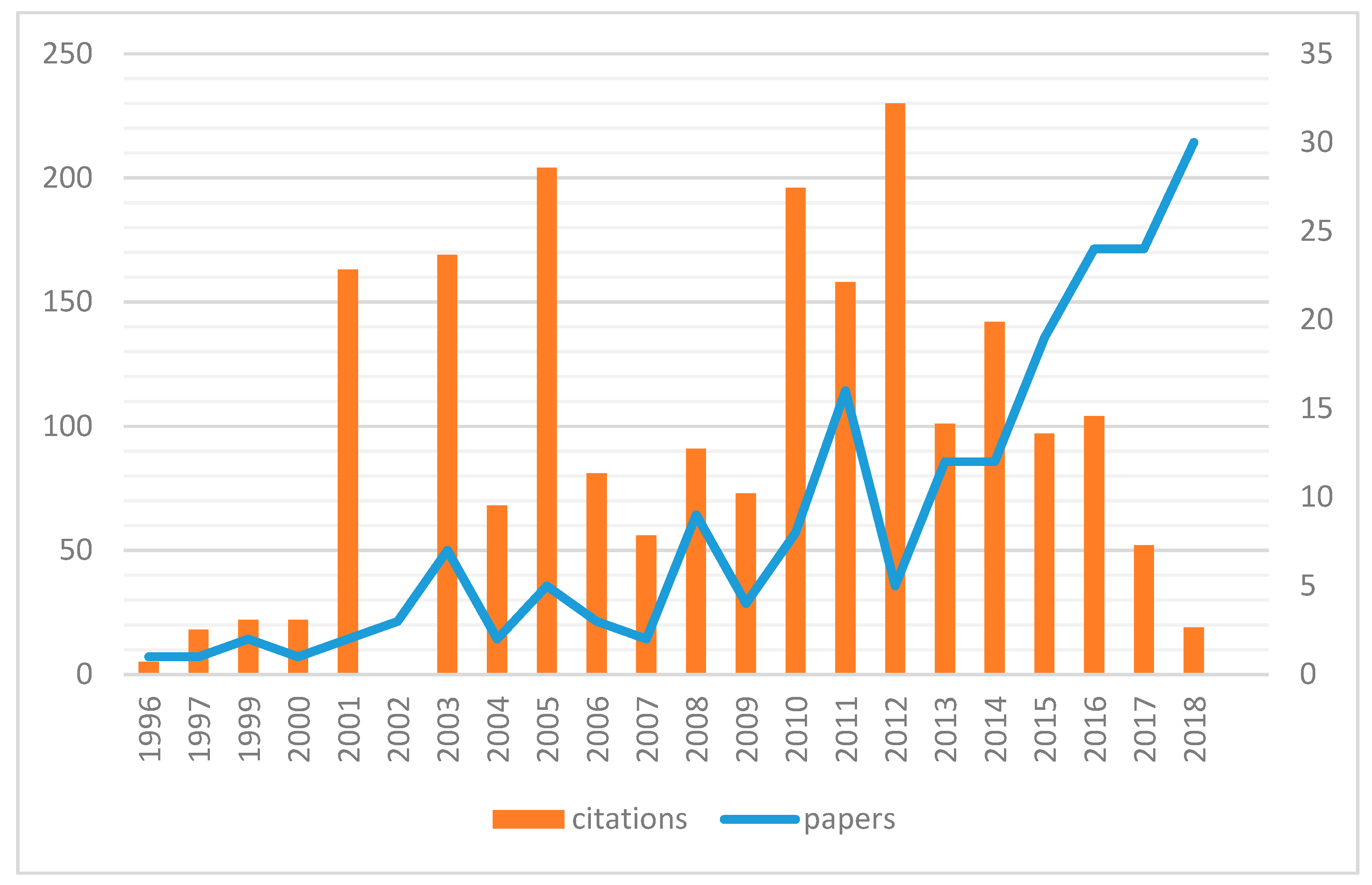
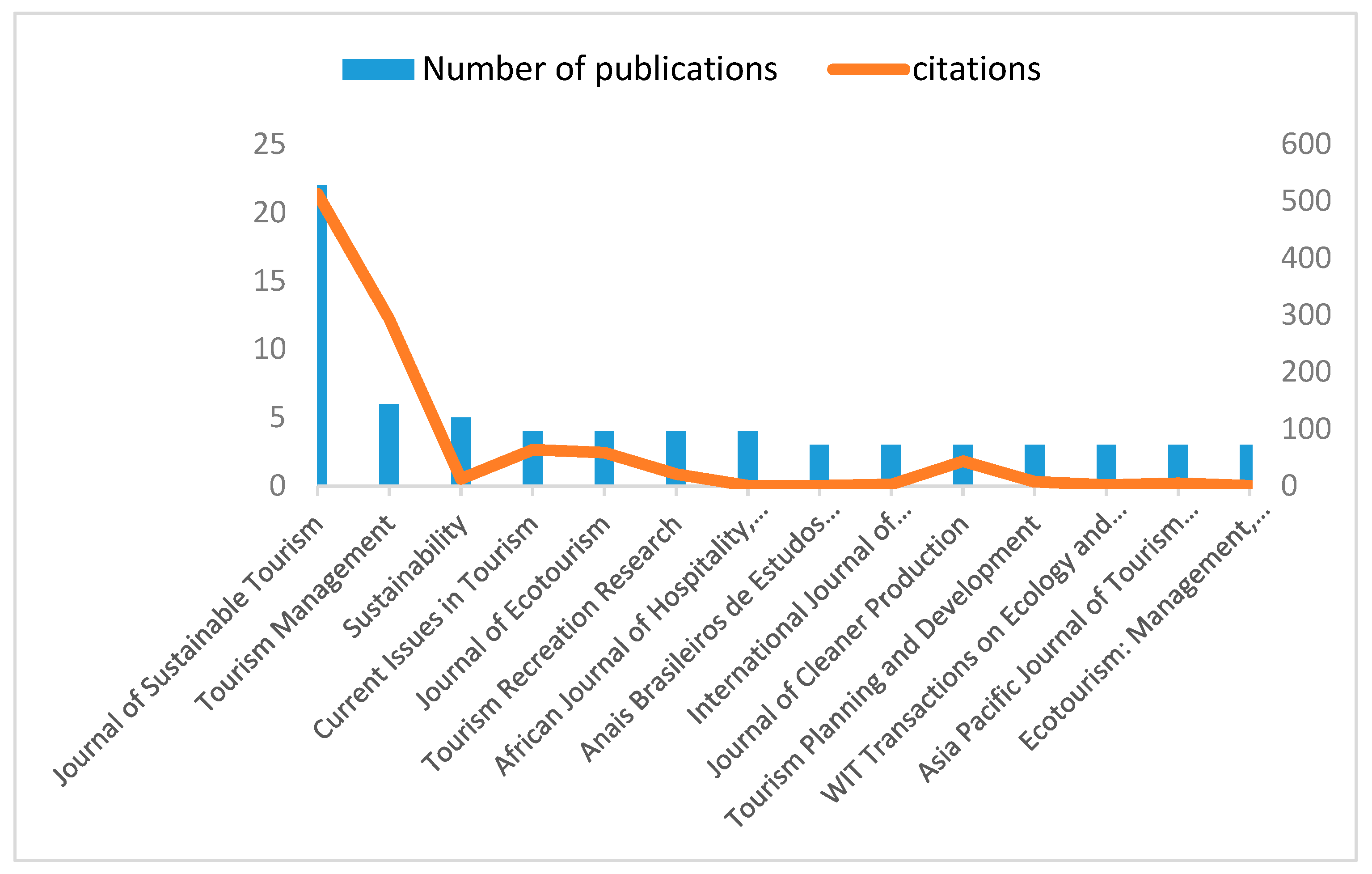
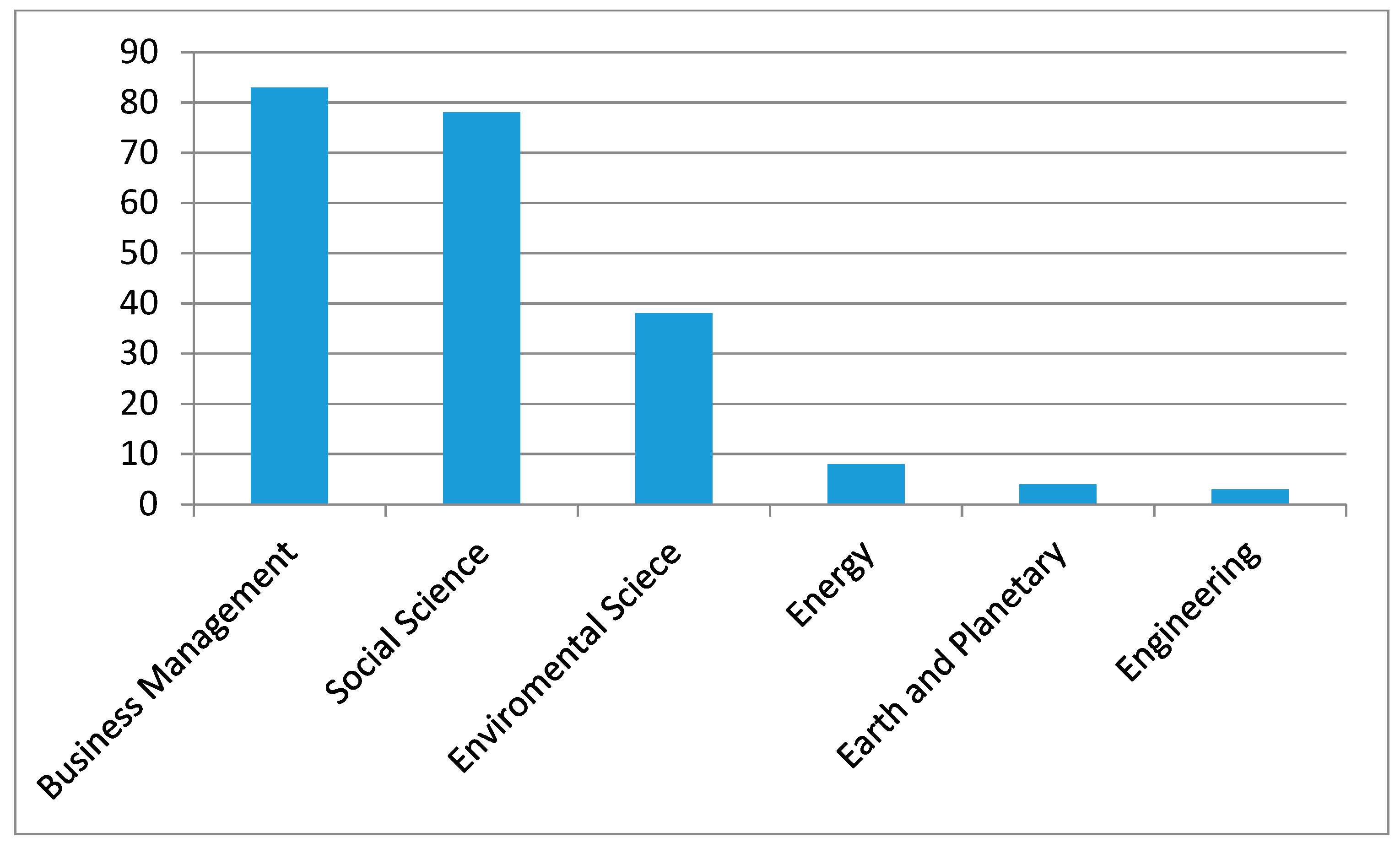
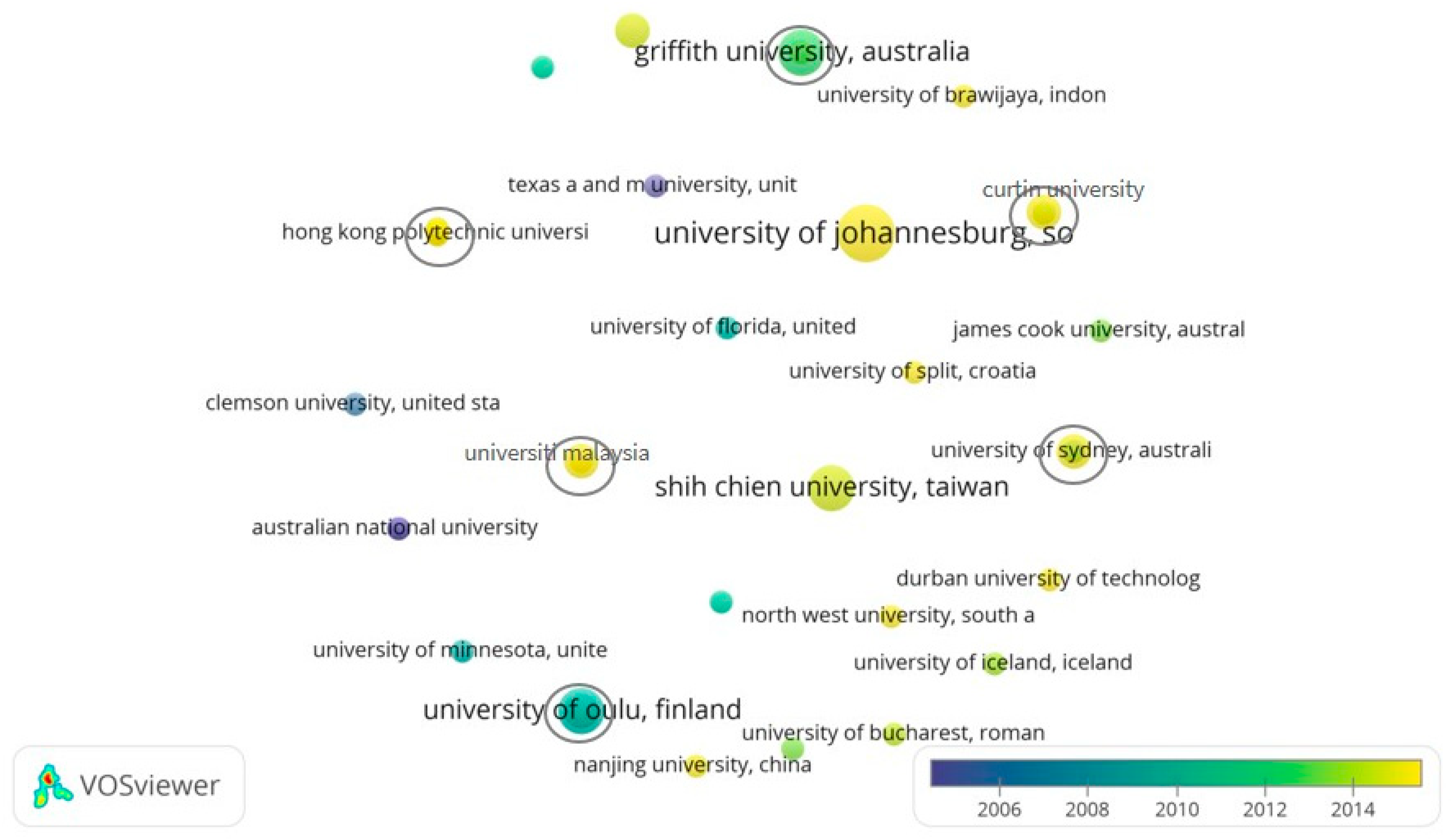
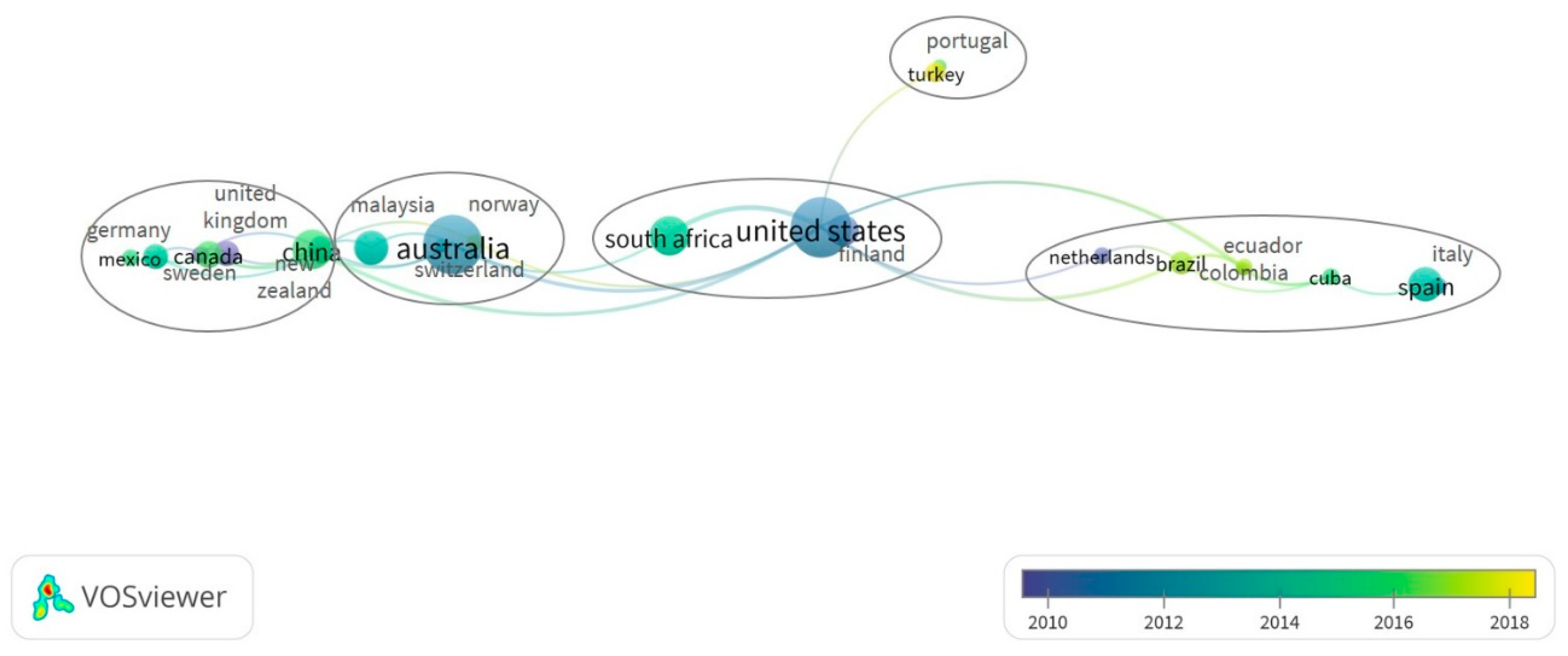
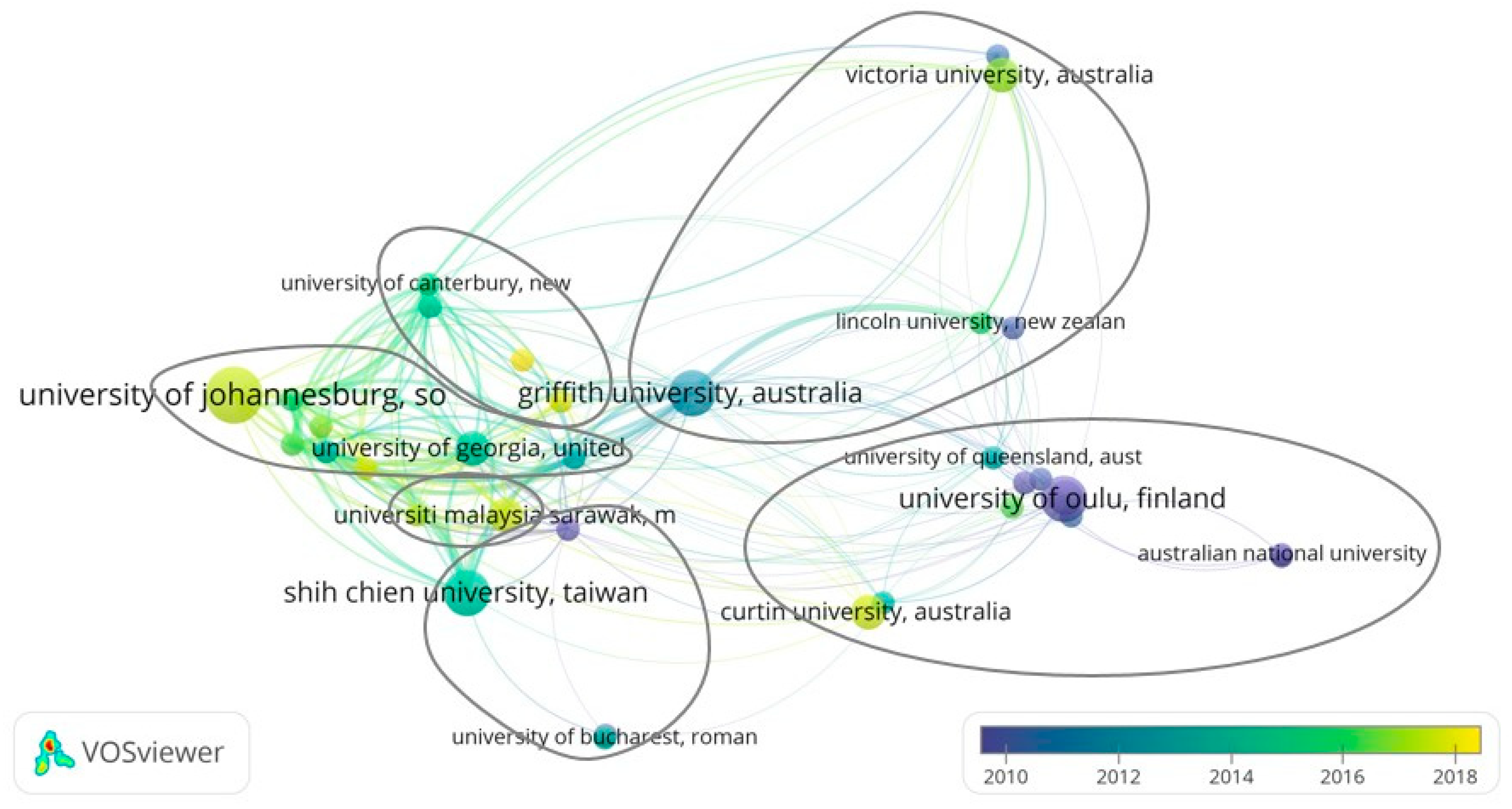

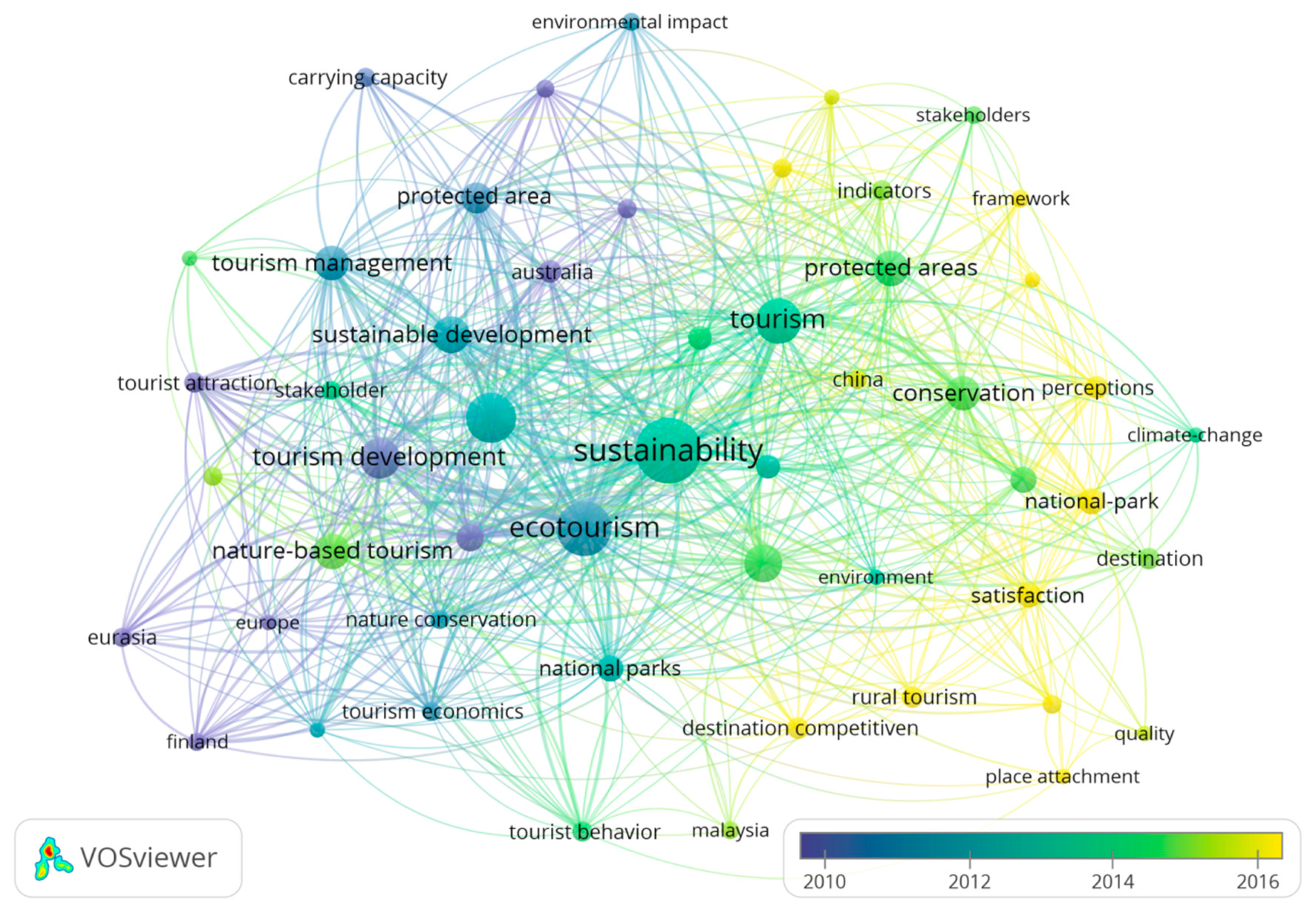
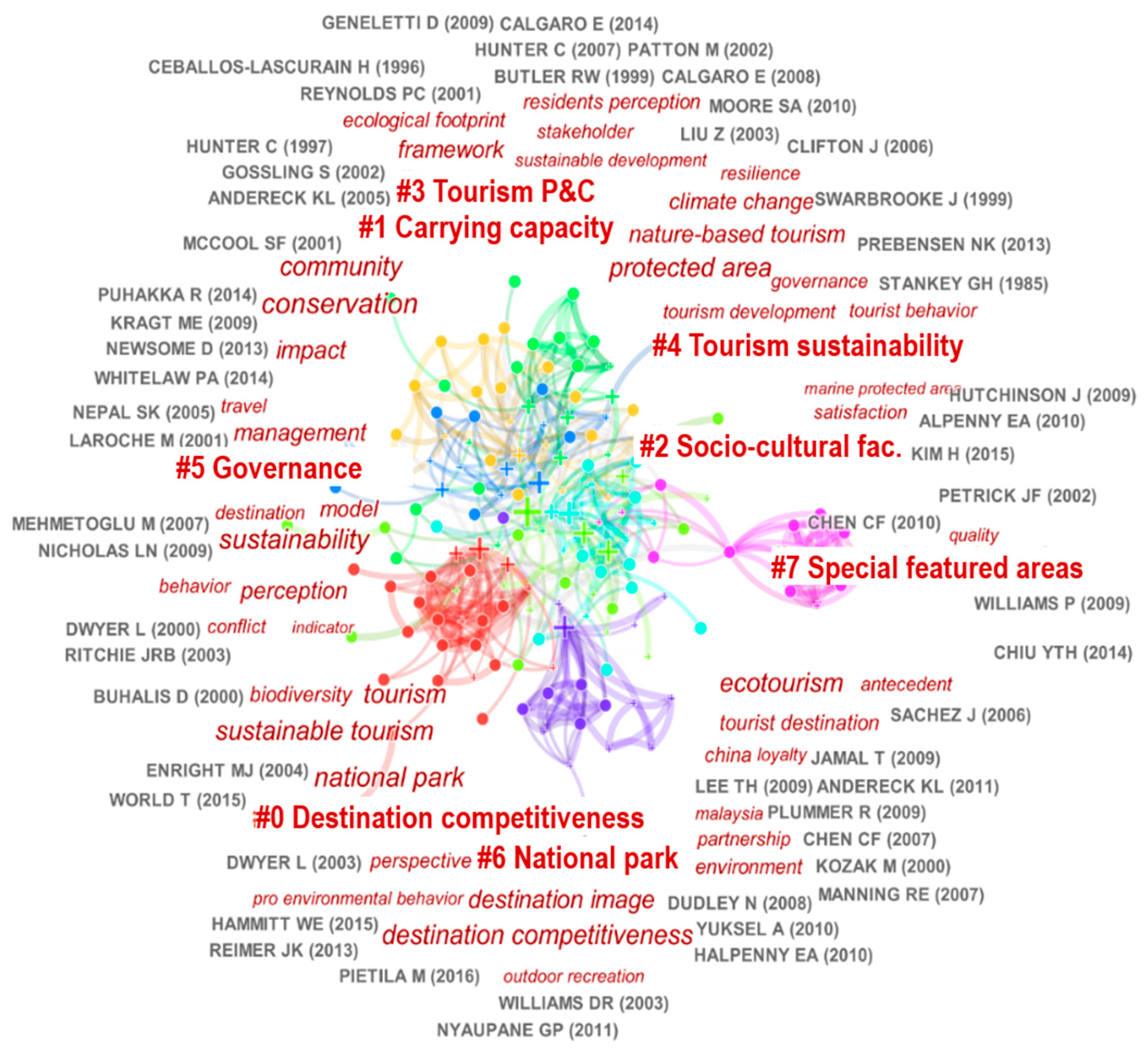
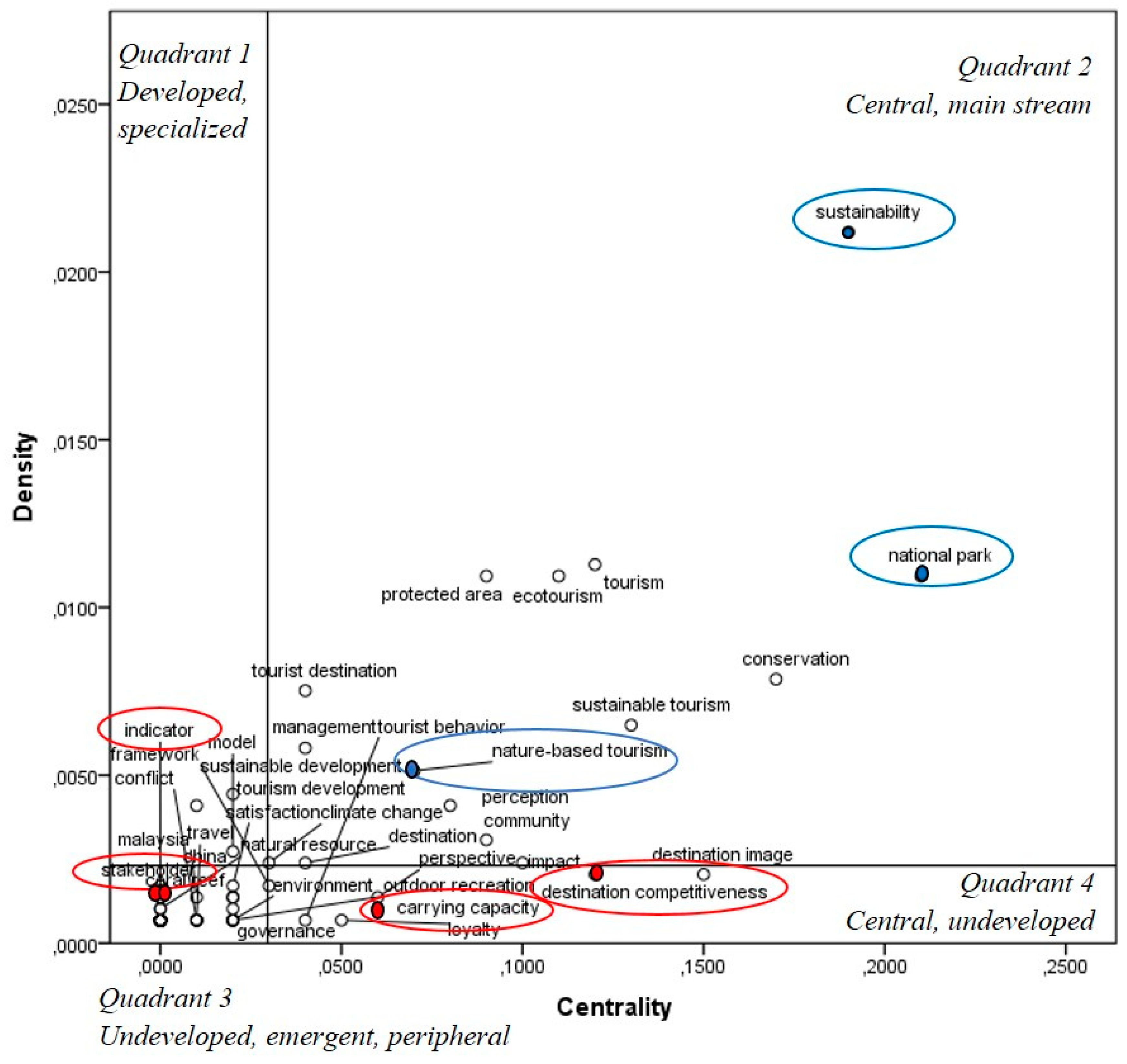
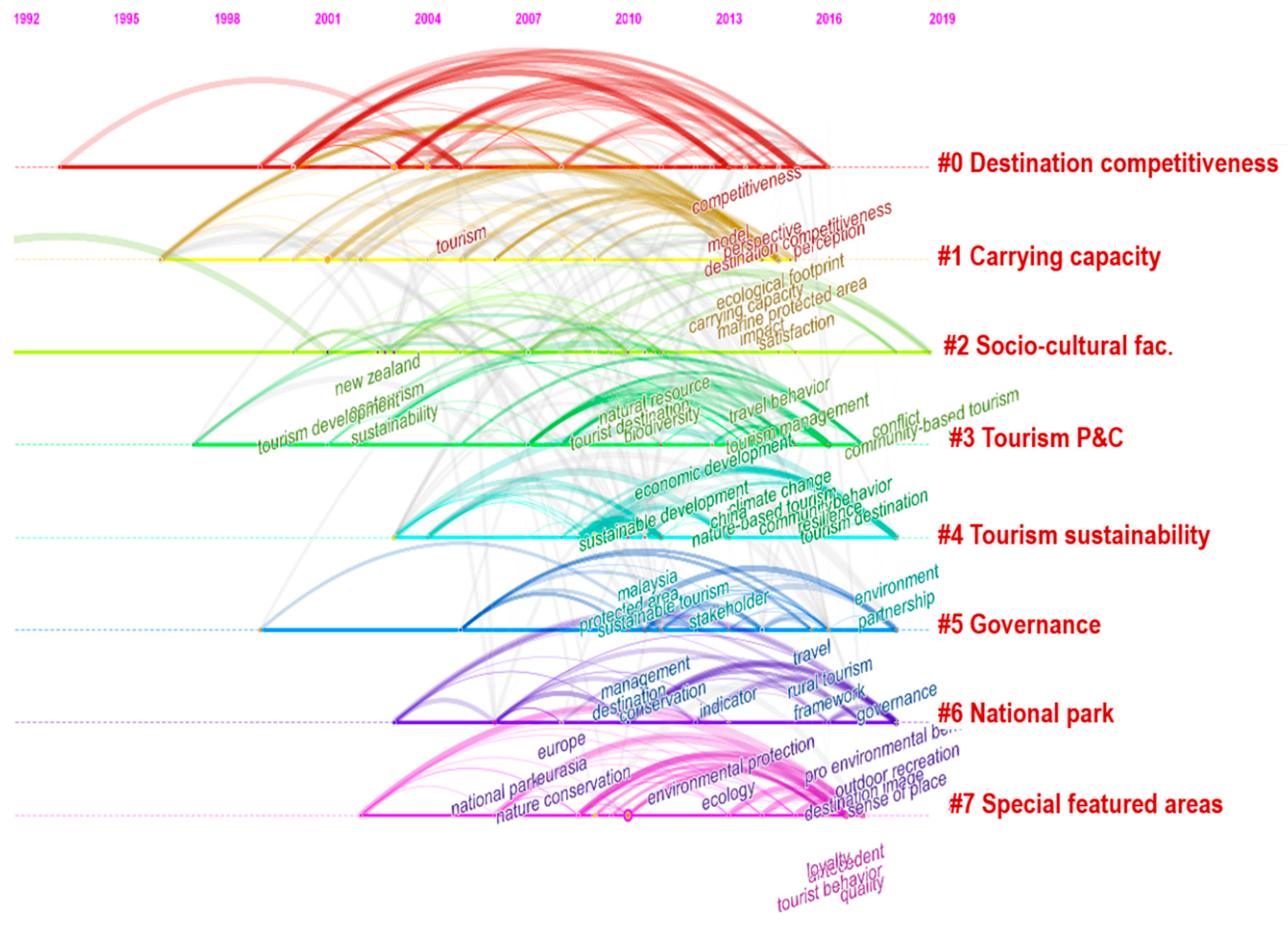
| Date | August 2019 | |
|---|---|---|
| Syntax | WoS | Scopus |
| “protected area *” AND tourism | 1688 | 2239 |
| (“wilderness area *” or “national park *” or “natural monument *” or “natural feature *” or “habitat management area *” or “species management area *” or “protected landscape *” or “protected seascape *” or “protected area * with sustainable use of natural resources”) AND tourism | 2099 | 2699 |
| nature-based AND tourism | 814 | 1062 |
| Source | Number of Publications | Number of Citations | % of Citations |
|---|---|---|---|
| Journal of Sustainable Tourism | 22 | 513 | 24 |
| Tourism Management | 6 | 294 | 14 |
| Sustainability | 5 | 13 | 1 |
| Current Issues in Tourism | 4 | 64 | 3 |
| Journal of Ecotourism | 4 | 59 | 3 |
| Tourism Recreation Research | 4 | 21 | 1 |
| African Journal of Hospitality, Tourism and Leisure | 4 | 1 | 0 |
| Anais Brasileiros de Estudos Turisticos | 3 | 1 | 0 |
| International Journal of Sustainable Development | 3 | 3 | 0 |
| Journal of Cleaner Production | 3 | 44 | 2 |
| Tourism Planning and Development | 3 | 8 | 3 |
| WIT Transactions on Ecology and the Environment | 3 | 2 | 0 |
| Asia Pacific Journal of Tourism Research | 3 | 5 | 0 |
| Ecotourism: Management, Development and Impact | 3 | 1 | 0 |
| Environmental Management | 2 | 23 | 1 |
| International Journal of Culture, Tourism, and Hospitality Research | 2 | 2 | 0 |
| Journal of Destination Marketing & Management | 2 | 13 | 1 |
| Journal of Environmental Management | 2 | 45 | 2 |
| Journal of Mountain Science | 2 | 4 | 0 |
| Journal of Travel Research | 2 | 79 | 4 |
| Journal of Vacation Marketing | 2 | 2 | 0 |
| Natur und Landschaft | 2 | 1 | 0 |
| Scandinavian Journal of Hospitality and Tourism | 2 | 2 | 0 |
| Tourism Analysis | 2 | 8 | 0 |
| Tourism and Hospitality Research | 2 | 3 | 0 |
| Tourism Geographies | 2 | 89 | 4 |
| Tourism Management Perspectives | 2 | 33 | 2 |
| Total | 96 | 1351 | 65 |
| Organization | Geographical Location | Number of Documents | Total Link Strength |
|---|---|---|---|
| Hong Kong Polytechnic University | China | 2 | 2 |
| University of Canterbury | New Zealand | 2 | 2 |
| Sun Yat Sen University | China | 2 | 1 |
| University of Waterloo | Canada | 2 | 1 |
| University of Oulu | Finland | 4 | 1 |
| Colorado State University | United States | 3 | 1 |
| Lincoln University | New Zealand | 2 | 2 |
| Griffith University | Australia | 4 | 1 |
| Curtin University | Australia | 3 | 1 |
| Murdoch University | Australia | 2 | 1 |
| Victoria University | Australia | 3 | 1 |
| University of Sydney | Australia | 2 | 1 |
| Universiti Malaysia Sarawak | Malaysia | 3 | 1 |
| Universiti Sains Malaysia | Malaysia | 2 | 1 |
| Keywords from Authors and Databases Aggregated | Keywords from Authors | Keywords from Databases | |||
|---|---|---|---|---|---|
| Keyword | Occurrences | Keyword-Authors | Occurrences | Keyword-Index | Occurrences |
| sustainability | 81 | sustainability | 36 | sustainability | 51 |
| ecotourism | 57 | tourism | 24 | ecotourism | 49 |
| tourist destination | 47 | nature-based tourism | 22 | tourist destination | 45 |
| tourism | 40 | sustainable tourism | 21 | tourism development | 29 |
| tourism development | 32 | ecotourism | 16 | tourism management | 22 |
| sustainable tourism | 28 | protected areas | 14 | conservation | 19 |
| sustainable development | 27 | sustainable development | 13 | sustainable development | 19 |
| nature-based tourism | 25 | national parks | 11 | tourism | 19 |
| protected areas | 24 | rural tourism | 7 | protected area | 16 |
| conservation | 23 | conservation | 6 | national-park | 14 |
| tourism management | 23 | destination competitiveness | 6 | national park | 13 |
| protected area | 18 | governance | 6 | biodiversity | 11 |
| national park | 15 | malaysia | 6 | management | 11 |
| national-park | 14 | carrying capacity | 5 | protected areas | 11 |
| management | 13 | competitiveness | 5 | satisfaction | 10 |
| national parks | 13 | resilience | 5 | australia | 9 |
| Term | Occurrences | |
|---|---|---|
| 1 | National Park | 143 |
| 2 | Tourist | 138 |
| 3 | Tourism Destination | 99 |
| 4 | Impact | 95 |
| 5 | Park | 83 |
| 6 | Tourism Development | 79 |
| 7 | Model | 70 |
| 8 | Concept | 67 |
| 9 | Industry | 66 |
| 10 | Ecotourism | 65 |
| 11 | Visitor | 65 |
| 12 | Capacity | 61 |
| 13 | Region | 52 |
| 14 | Country | 51 |
| 15 | Experience | 49 |
| 16 | Quality | 44 |
| 17 | Strategy | 44 |
| 18 | Indicator | 43 |
| 19 | Process | 43 |
| 20 | Satisfaction | 43 |
© 2019 by the authors. Licensee MDPI, Basel, Switzerland. This article is an open access article distributed under the terms and conditions of the Creative Commons Attribution (CC BY) license (http://creativecommons.org/licenses/by/4.0/).
Share and Cite
Rodríguez-López, N.; Diéguez-Castrillón, M.I.; Gueimonde-Canto, A. Sustainability and Tourism Competitiveness in Protected Areas: State of Art and Future Lines of Research. Sustainability 2019, 11, 6296. https://doi.org/10.3390/su11226296
Rodríguez-López N, Diéguez-Castrillón MI, Gueimonde-Canto A. Sustainability and Tourism Competitiveness in Protected Areas: State of Art and Future Lines of Research. Sustainability. 2019; 11(22):6296. https://doi.org/10.3390/su11226296
Chicago/Turabian StyleRodríguez-López, Nuria, M. Isabel Diéguez-Castrillón, and Ana Gueimonde-Canto. 2019. "Sustainability and Tourism Competitiveness in Protected Areas: State of Art and Future Lines of Research" Sustainability 11, no. 22: 6296. https://doi.org/10.3390/su11226296
APA StyleRodríguez-López, N., Diéguez-Castrillón, M. I., & Gueimonde-Canto, A. (2019). Sustainability and Tourism Competitiveness in Protected Areas: State of Art and Future Lines of Research. Sustainability, 11(22), 6296. https://doi.org/10.3390/su11226296





